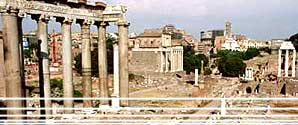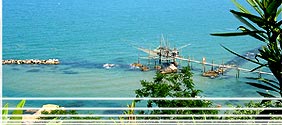 |
|
 |
Archaeology
in Rome - ITALY
Archaeological parks in Rome:
~ Colosseo
o Anfiteatro Flavio (Colosseum
or Flavio Amphitheatre);
~ Fori
Imperiali (Imperial Forum);
~ Colle
Palatino (Palatine Hill);
~ Pantheon;
~ Terme
di Caracalla (Caracalla's
baths);
|
 |
| |
- Colosseo (Colosseum or
Flavio Amphitheatre)
It is the capital city's most representative
monument. It was built under Vespasiano
in 75 A.D. where there was the small lake
of the Domus Aurea.
It is situated between Colle Palatino (Palatine
Hill) and Colle Oppio (Oppio Hill). The
arena is 76 metres long and 46 metres wide
and the terraces could hold 45,000 people;
the facade is made of travertin, is 57 metres
high and it is a mixture of four arhitectonic
orders: you can see 80 arches in the first
three orders and some windows in the fourth
order. The gladiators' performances, the
fightings between men and animals and the
early Christians' martyrdom took place at
the Colosseum.
Below the arena there was an underground
area with the games' machines and the passages
for gladiators and animals.
The present imponent monument survived some
strong earthquakes in 442 and in 508 whereas
two rows of arches collapsed because of
the earthquake of the year 851. Afterwards
restoration works took place thanks to some
Popes, i.e. Pio VII, Leone XII, Gregorio
XVI and Pio IX.
|
|
 |
|
 |
|
(Fori Imperiali (Imperial
Forum))
Rome, 100 mt |
 |
|
|
- Fori Imperiali (Imperial
Forum)
The Roman Forum were wide squares where
people's assemblies, the meetings where
justice was done and business negotiations
took place. Behind the Colosseum you can
find an archaeological park, unique in the
world, made up of Colle Palatino (Palatine
Hill) and several Roman Forum.
Do not miss this opportunity: come and visit
Foro Romano (Roman Forum) and Foro Traiano
(Trajan's Forum)!
-
Foro Romano
(Roman Forum) was the heart of the political
and social life in the ancient Rome.
There you can visit the remains of Basilica
Aemilia (Aemilia Basilica),
which was built in 179 B.C. and used
for currency dealing. On the right side,
the ancient street Argiletum's pavement
divides the Basilica from the Curia,
i.e. the seat of the Roman Senate. Behind
it you can see on the right the Arco
di Settimio Severo (Arch of
Septimius Severus) dating back to 203
B.C. and on the left the remains of
the I-century Tempio di Vespasiano (Vespasian's
Temple). Along Via Sacra (Sacred Street)
you can see the Tempio di Antonino
e Faustina (Antonino and Faustina's
Temple), which was built in 141 A.D.
in honour of Emperor Antonino Pio's
wife. Finally the Arco di Tito (Arch
of Titus), situated at the bottom of
Via Sacra, concludes the area of the
Roman Forum.
-
Foro Traiano
(Trajan's Forum) was the last forum
to be built at the beginning of the
second century. In the northern area
you can see Basilica Ulpia,
i.e. the place where laws were promulgated
and money was distributed to people.
Behind the Basilica there is Colonna
Traiana (Trajan's Column).
It is 40 metres high; in its plinth
it is located Emperor Trajan's tomb
and a spiral staircase getting to the
column's top. Daci people's weapons
are portrayed on the column's plinth
whereas about 200-metre friezes portraying
Trajan's two wars against that barbarian
people twine around the column's marble
shaft. The friezes portraying the first
and the second war are separated by
the god Victory writing on a shield.
You can also visit:
Foro di Cesare (Caesar's
Forum), Foro di Augusto
(Augustus's Forum), Foro di Nerva
(Nerva's Forum) and Foro della Pace
(Peace Forum). |
|
 |
|
 |
|
(Colle Palatino (Palatine
Hill))
Rome, 100 mt |
 |
|
|
- Colle Palatino (Palatine
Hill)
The archaeological area of Colle
Palatino is together with the area
of Foro Romano one of the most important
in the world. According to tradition, that
hill was the seat of the foundation of the
city by Romulus. In this archaeological
site you can visit the remains of the Farnese
family's gardens, i.e. the first botanical
gardens in the world, commissioned by Cardinal
Alessandro Farnese in the sixteenth century.
Further on you can find a big construction
made for Domitian in the first century A.D.
. It is formed by three areas:
-
Domus Flavia
or Palazzo dei Flavi (Flavi Palace):
the palace was the official seat of
the emperor. It was made up of the peristyle
(i.e. row of columns around a courtyard)
in the middle and the basilica, the
emperor hall and the triclinium (or
dining room) around it.
-
Domus Augustana:
it was the Emperor's private residence.The
rooms are on two levels; the lower level
was equipped with a system of tanks
for the rainwater collection whereas
the upper level holds the antiquarium
palatino with a wide peristyle
and a small temple.
- Stadio (Stadium), where
feasts and competitions took place.
|
|
 |
|
 |
|
(Pantheon)
Rome, 100 mt |
 |
|
|
- Pantheon
The Pantheon, the Savoia family's mausoleum,
stands in Piazza Rotonda (Rotonda Square).
It was built in 27 B.C. but its present
look dates back to the second century A.D.
. It is the Roman best preserved monument.
The Pantheon, a temple devoted to gods,
is formed by two main parts: a round covered
cupola-shaped room, whose diameter is 43,30
metres, and a rectangular atrium with portico.
Inside the Pantheon you can see Raffaello's
tomb and the Madonna del Sasso statue by
the artist Lorenzetto.
|
|
 |
| |
| -
Terme di Caracalla (Caracalla's
baths)
Terme di Caracalla are one of the biggest
and best preserved baths of the ancient
times. They were commissioned by Septimius
Severus but they were unveiled during his
son's reign,i.e. Marco Aurelio Antonino
Bassiano called Caracalla, probably in 216
A.D.
The baths' remains are still thirty metres
high in some points, so that you can form
an opinion about the magnificence of the
thermal complex. Only Diocletian's baths
are bigger than Caracalla's baths.
The baths were used only for three centuries;
they were definitely abandoned after 537
A.D. bacause Vitige, king of the Goti people,
destroyed the aqueducts in order to besiege
Rome. |
|
|
|
|
 |
 |
| Beach
hotels |
| the most beautiful beaches
of Italy in the best hotels |
|
|
|


